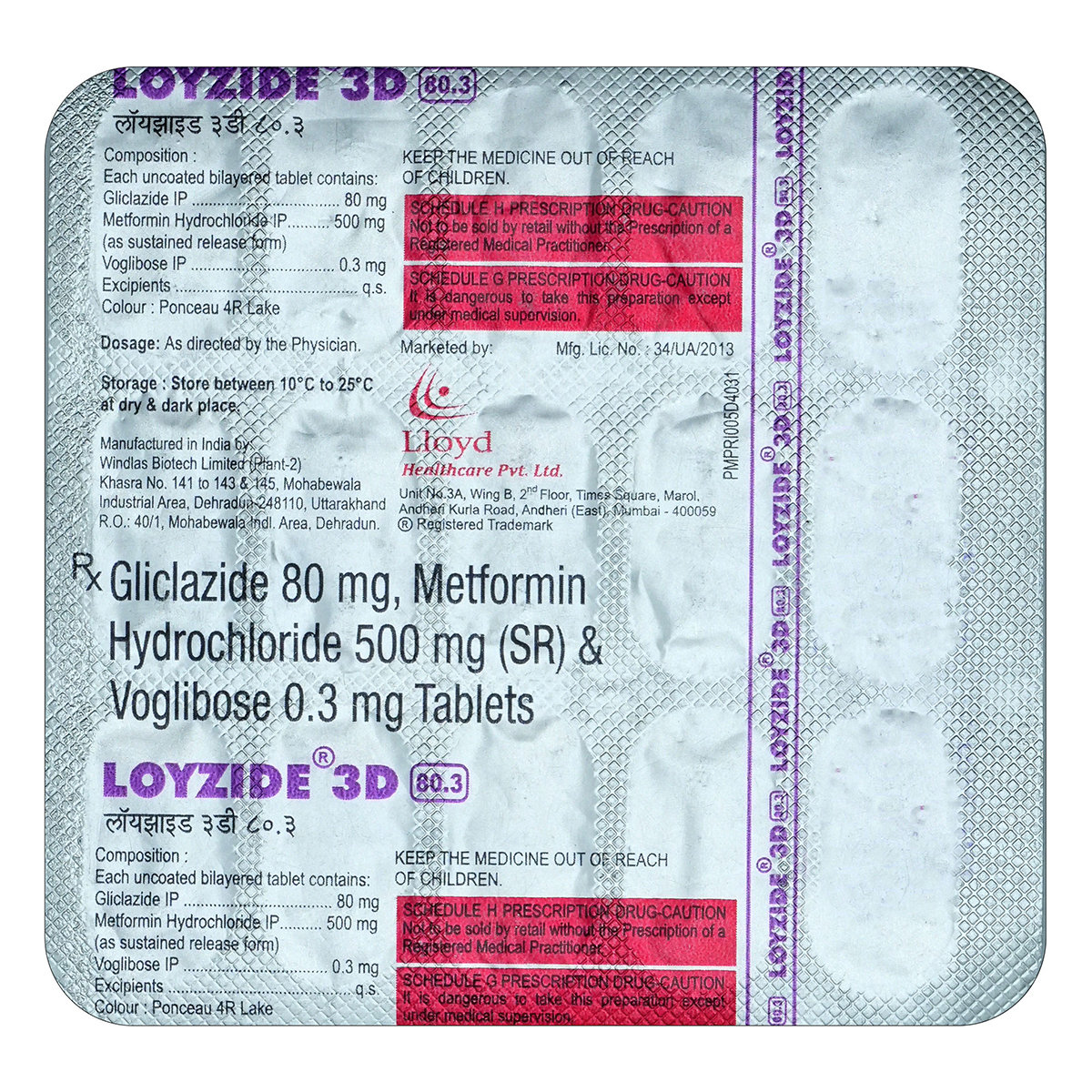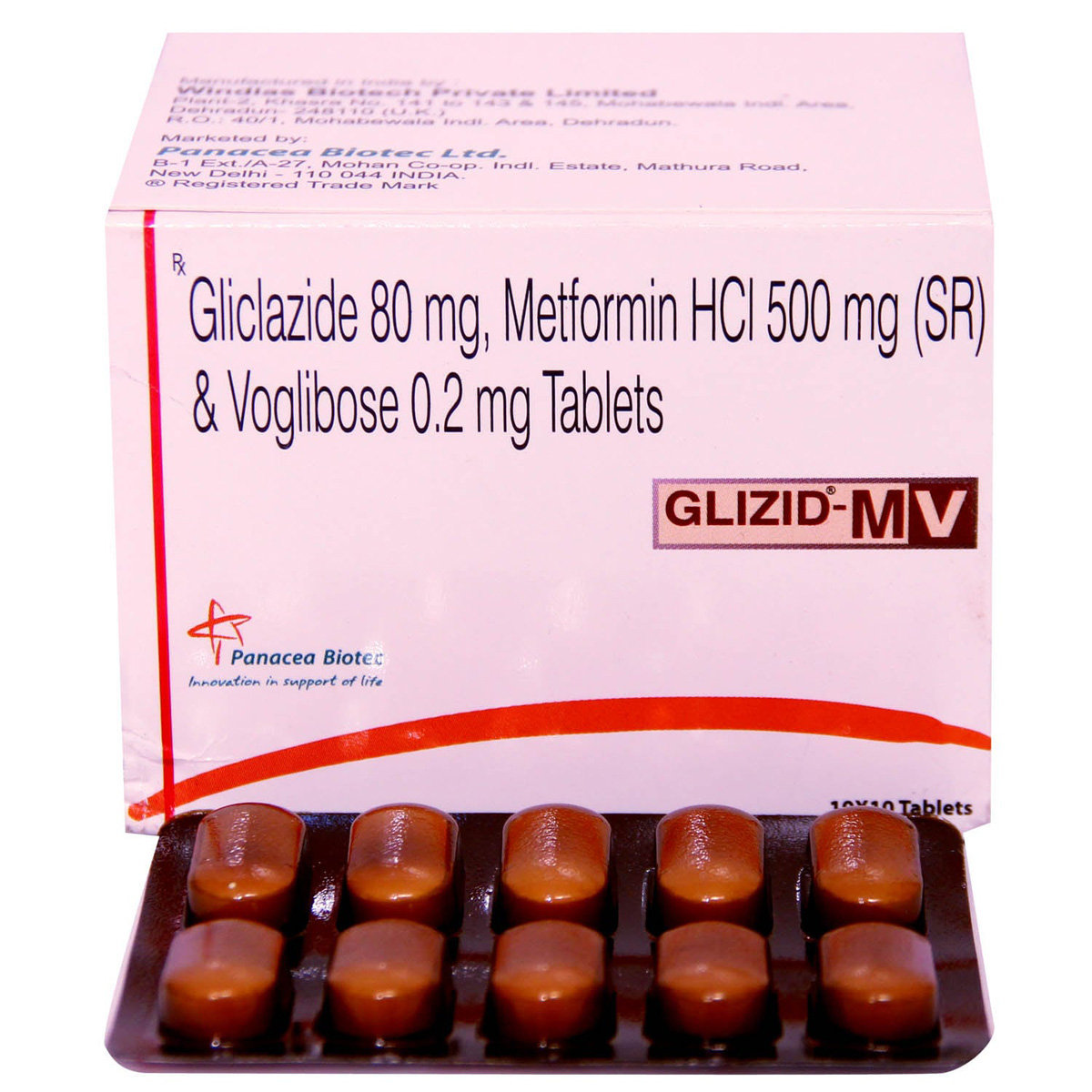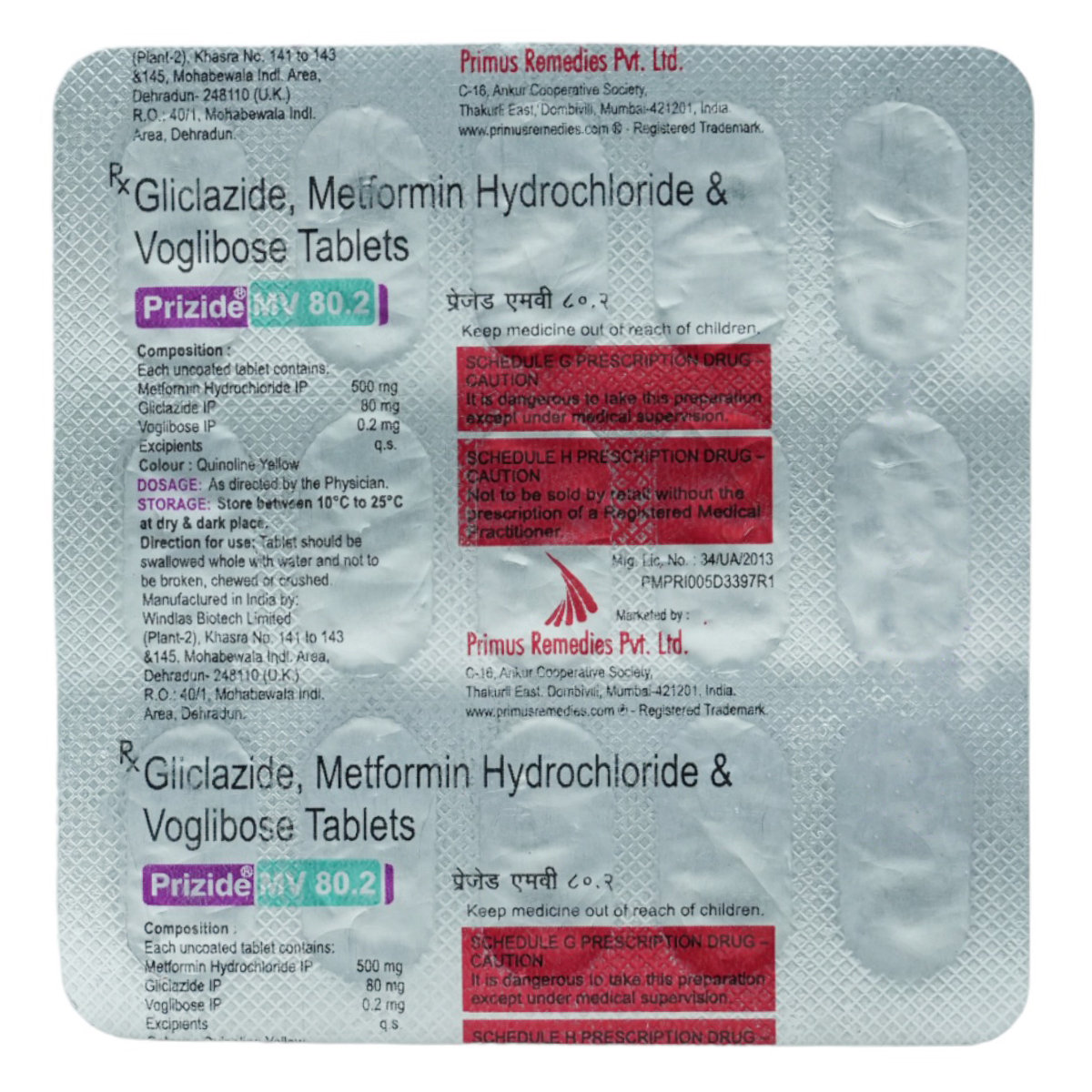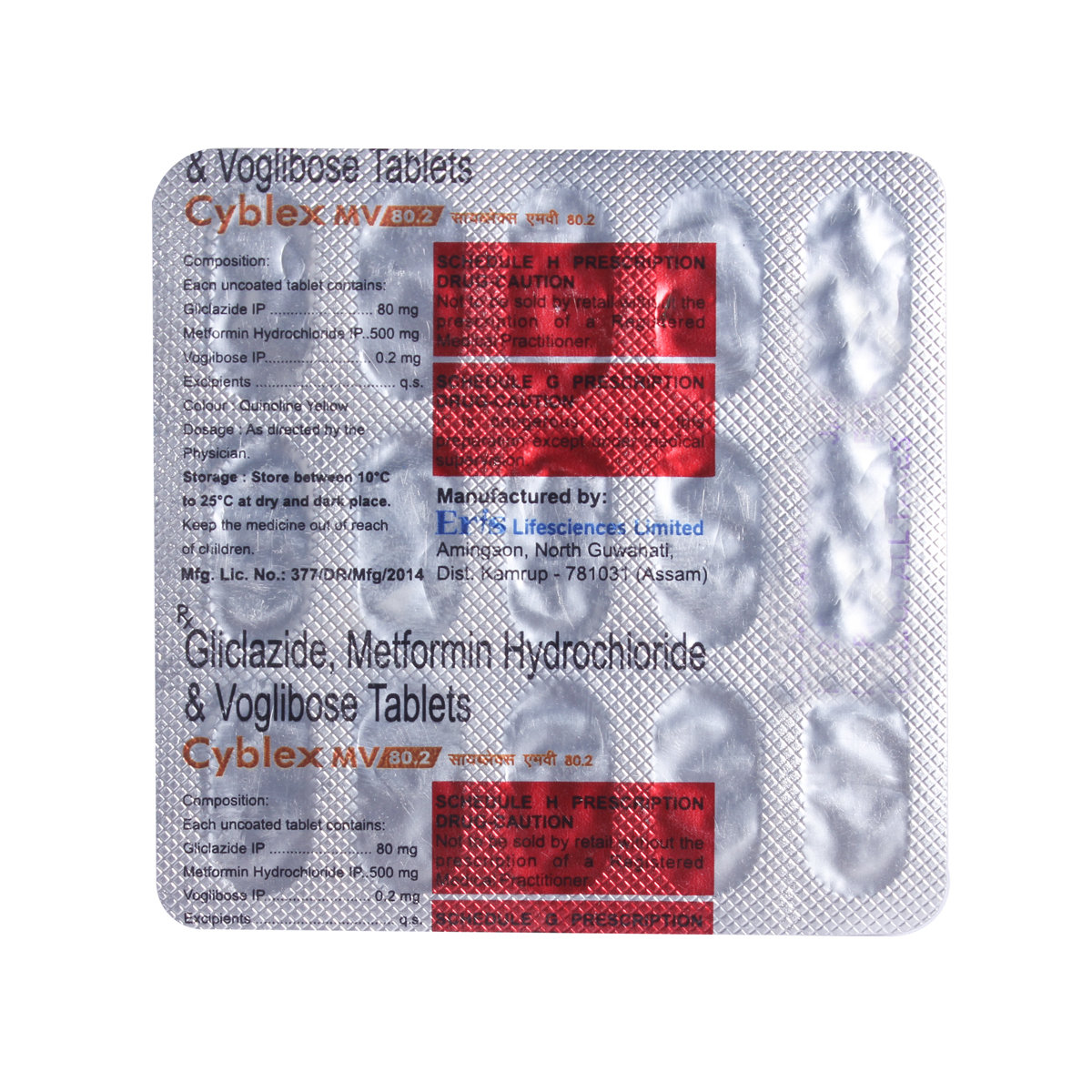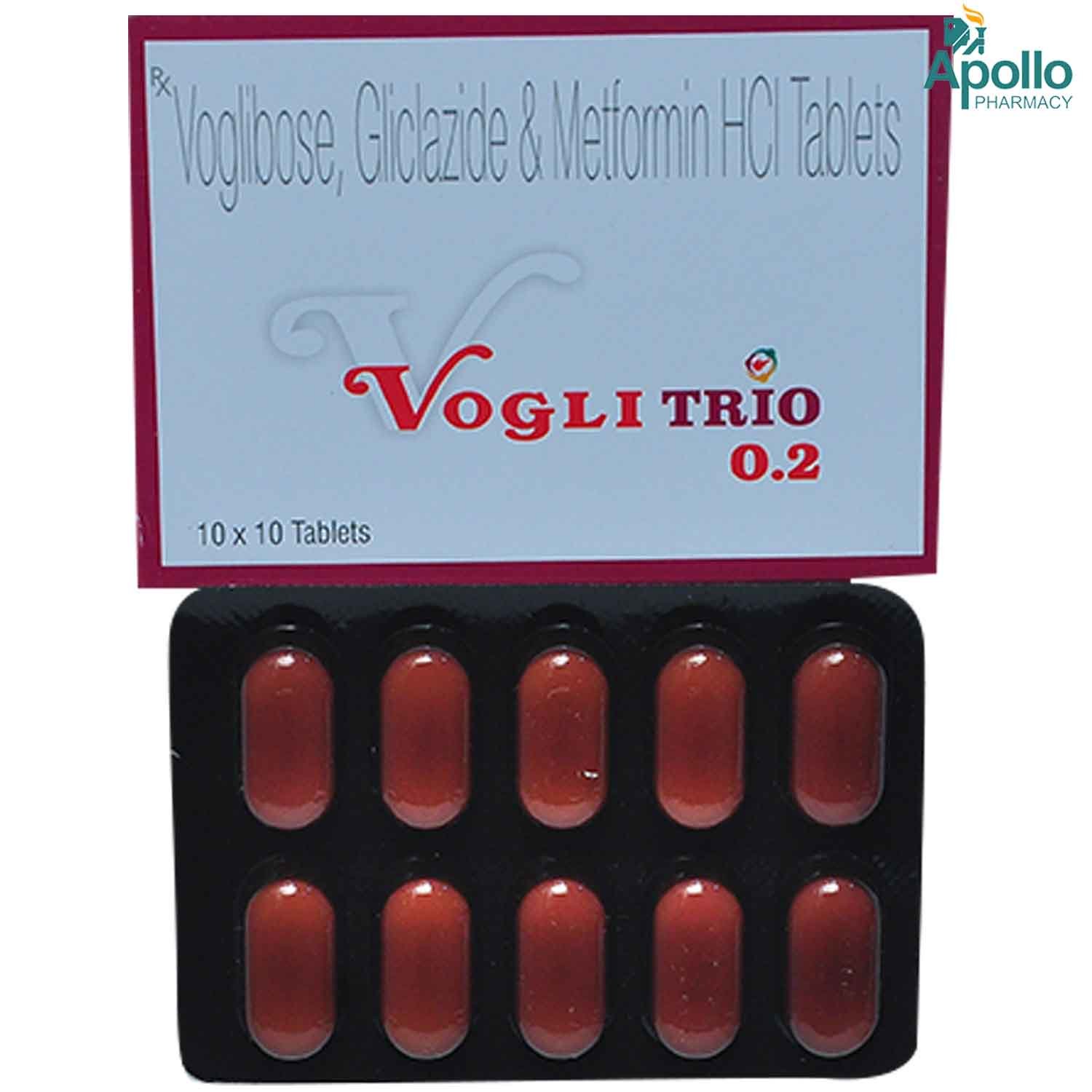Glictrio MV 80/0.2 Tablet 10's


MRP ₹148
(Inclusive of all Taxes)
₹22.2 Cashback (15%)
Provide Delivery Location
Online payment accepted
 Prescription drug
Prescription drugWhats That
Composition :
Manufacturer/Marketer :
Consume Type :
Expires on or after :
Return Policy :
About Glictrio MV 80/0.2 Tablet
Glictrio MV 80/0.2 Tablet belongs to a class of medicine known as an antidiabetic primarily indicated in treating type 2 diabetes mellitus. Type 2 diabetes is a chronic or lifelong condition affecting how your body processes glucose. People with type 2 diabetes either do not produce enough insulin, or if at all the insulin is produced, it is unable to perform its function in the body (insulin resistance). Due to this, the blood glucose level increases, and symptoms such as frequent urination, increased thirst, and increased hunger start. It can lead to serious complications like skin infection, eye problems (retinopathy), nerve damage (neuropathy), diabetic foot (foot ulcer), kidney disease (nephropathy), high blood pressure and even stroke.
Glictrio MV 80/0.2 Tablet combines three antidiabetic drugs: Voglibose, Metformin, and Gliclazide. Voglibose is an alpha-glucosidase inhibitor that prevents the breakdown of complex sugars into simple sugars such as glucose. In this way, it prevents the sudden rise in sugar levels after every meal. Gliclazide is a 'sulfonylurea' that acts by increasing the insulin released by the pancreas. On the other hand, Metformin, which is a 'biguanide', acts by lowering the glucose production in the liver, delaying glucose absorption from the intestines, and increasing the body's response to insulin. In a nutshell, the three medicines together prevent blood glucose levels from rising to very high levels, thus keeping your Diabetes under control. Glictrio MV 80/0.2 Tablet act together to keep your blood sugar levels under check. The strict control of blood sugars is especially important to mention the many disabling side effects of Diabetes. Glictrio MV 80/0.2 Tablet shows optimum effects when taken along with healthy lifestyle changes like weight loss, regular exercise, healthy diet, etc.
Glictrio MV 80/0.2 Tablet should be taken with food to avoid an upset stomach. Glictrio MV 80/0.2 Tablet should be taken at the same time of the day each time for the best results. For better advice, your doctor will decide what dose should be taken, which can change quickly depending on your condition. A common side effect of Glictrio MV 80/0.2 Tablet is hypoglycemia (low blood glucose levels), characterized by dizziness, sweating, palpitations, hunger pangs, dry mouth, skin, etc. So, to avoid hypoglycemia, you should not miss meals and also should carry some form of sugar along with you. Other side effects include taste change, nausea, diarrhoea, stomach pain, headache, and upper respiratory symptoms.
You should not take Glictrio MV 80/0.2 Tablet if you have diabetic ketoacidosis (excess acids in your blood). Glictrio MV 80/0.2 Tablet should not be stopped even if you feel better, without consulting your doctor as your sugar level keeps changing. If you stop taking Glictrio MV 80/0.2 Tablet abruptly, it may increase your sugar levels which could further increase the risk of eyesight loss (retinopathy), kidney (nephropathy), and nerve damage (neuropathy). Glictrio MV 80/0.2 Tablet should not be taken if you have type 1 diabetes mellitus or severe kidney or liver disease. Please inform your doctor if you have any heart disease, are or are planning to get pregnant, or are breastfeeding.
Uses of Glictrio MV 80/0.2 Tablet
Directions for Use
Key Benefits
Glictrio MV 80/0.2 Tablet is a combination of three anti-diabetic drugs: Voglibose, Metformin, and Gliclazide. Voglibose is an alpha-glucosidase inhibitor that prevents the breakdown of complex sugars into simple sugars such as glucose. In this way, it prevents the sudden rise in sugar levels after every meal. Gliclazide is a 'sulfonylurea' that acts by increasing the insulin released by the pancreas. On the other hand, Metformin, which is a 'biguanide', works by lowering the glucose production in the liver, delaying glucose absorption from the intestines, and increasing the body's response to insulin. In a nutshell, the three medicines prevent blood glucose levels from rising to very high levels, thus keeping your Diabetes under control. Glictrio MV 80/0.2 Tablet act together to keep your blood sugar levels under check. The strict control of blood sugars is especially important to mention the many disabling side effects of Diabetes. Glictrio MV 80/0.2 Tablet shows optimum effects when taken along with healthy lifestyle changes like weight loss, regular exercise, healthy diet, etc.
Storage
- Inform Your Doctor: Notify your doctor immediately about your diarrhoea symptoms. This allows them to adjust your medication or provide guidance on managing side effects.
- Stay Hydrated: Drink plenty of fluids to replace lost water and electrolytes. Choose water, clear broth, and electrolyte-rich drinks. Avoid carbonated or caffeinated beverages to effectively rehydrate your body.
- Follow a Bland Diet: Eat easy-to-digest foods to help firm up your stool and settle your stomach. Try incorporating bananas, rice, applesauce, toast, plain crackers, and boiled vegetables into your diet.
- Avoid Trigger Foods: Steer clear of foods that can worsen diarrhoea, such as spicy, fatty, or greasy foods, high-fibre foods, and dairy products (especially if you're lactose intolerant).
- Practice Good Hygiene: Maintain good hygiene to prevent the spread of infection. To stay healthy, wash your hands frequently, clean and disinfect surfaces regularly, and avoid exchanging personal belongings with others.
- Take Anti-Diarrheal Medications: If your doctor advises, anti-diarrheal medications such as loperamide might help manage diarrhoea symptoms. Always follow your doctor's directions.
- Keep track of your diarrhoea symptoms. If they don't get better or worse or are accompanied by severe stomach pain, blood, or dehydration signs (like extreme thirst or dark urine), seek medical help.
- Drink water or other clear fluids.
- To prevent worsening of pain, limit intake of tea, coffee, or alcohol.
- Include bland foods like rice, toast, crackers, and rice in your diet.
- Avoid lying down immediately after eating as it may cause indigestion or heartburn.
- Avoid acidic and spicy food as it may cause indigestion.
- Inform your doctor about your constipation symptoms. They may adjust your medication or advise alternative treatments.
- Stay hydrated by drinking sufficient of water (at least 8-10 glasses a day) to help soften stool and promote bowel movements.
- Increase fibre intake by eating foods high in fibre, such as fruits, whole grains, vegetables and legumes, to help bulk up the stool.
- Establish a bowel routine by trying to go to the bathroom at the same time each day to train your bowels.
- Engaging in regular exercise, like walking or yoga, can support in bowel movement stimulation.
- Consult your doctor if constipation persists, and discuss alternative treatments or adjustments to your medication.
- Inform your doctor about the nausea and discuss possible alternatives to the medication or adjustments to the dosage.
- Divide your daily food intake into smaller, more frequent meals to reduce nausea.
- Opt for bland, easily digestible foods like crackers, toast, plain rice, bananas, and applesauce.
- Avoid certain foods that can trigger nausea, such as fatty, greasy, spicy, and smelly foods.
- Drink plenty of fluids, such as water, clear broth, or electrolyte-rich beverages like coconut water or sports drinks.
- Use ginger (tea, ale, or candies) to help relieve nausea.
- Get adequate rest and also avoid strenuous activities that can worsen nausea.
- Talk to your doctor about taking anti-nausea medication if your nausea is severe.
- Record when your nausea occurs, what triggers it, and what provides relief to help you identify patterns and manage your symptoms more effectively.
- Always wear loose-fitting clothes which are suitable for your activity.
- Include the diet containing fruits like watermelon, grapes, bananas and green leafy vegetables.
- Drink plenty of water stay hydrated.
- Avoid moving more and staying in hot sun.
Drug Warnings
Some diabetic patients taking Glictrio MV 80/0.2 Tablet may develop a rare but serious condition called lactic acidosis. In this condition, too much lactic acid is accumulated in the blood. So, your liver and kidney's proper functioning is required to eliminate excess lactic acid from the blood. You should not take Glictrio MV 80/0.2 Tablet if you have kidney disease, as measured by a blood test. Glictrio MV 80/0.2 Tablet may lower vitamin B12 levels, so try to have blood tests for annual blood and vitamin. Glictrio MV 80/0.2 Tablet , when used with or without insulin, tends to lower the blood sugar level extremely. So, the doctor may reduce the dose of insulin. Glictrio MV 80/0.2 Tablet may lower your thyroid-stimulating hormone (TSH), so an annual check-up of TSH is suggested.
Drug-Drug Interactions
Drug-Drug Interactions
Login/Sign Up
Co-administration of Glictrio MV 80/0.2 Tablet and Iodamide can increase the risk of lactic acidosis (when the body produces too much lactic acid).
How to manage the interaction:
Taking Glictrio MV 80/0.2 Tablet with Iodamide is generally avoided as it can result in an interaction, please consult your doctor before taking it.
Co-administration of Glictrio MV 80/0.2 Tablet and Iobenzamic acid can increase the risk of lactic acidosis (when the body produces too much lactic acid).
How to manage the interaction:
Taking Glictrio MV 80/0.2 Tablet with Iobenzamic acid is generally avoided as it can result in an interaction, please consult your doctor before taking it.
Co-administration of Glictrio MV 80/0.2 Tablet with Metrizamide together can cause the risk of lactic acidosis (when the body produces too much lactic acid ).
How to manage the interaction:
Taking Glictrio MV 80/0.2 Tablet with Metrizamide is generally avoided as it can possibly result in an interaction, it can be taken if a doctor has advised it. However, if you experience headaches, muscle cramps or pain, contact a doctor immediately. Do not discontinue any medications without consulting a doctor.
Co-administration of Iopydol with Glictrio MV 80/0.2 Tablet can increase the risk of side effects.
How to manage the interaction:
Taking Glictrio MV 80/0.2 Tablet with Iopydol is not recommended, please consult your doctor before taking it.
Co-administration of Glictrio MV 80/0.2 Tablet and Iocarmic acid can increase the risk of lactic acidosis (when the body produces too much lactic acid).
How to manage the interaction:
Taking Glictrio MV 80/0.2 Tablet with Iocarmic acid is generally avoided as it can result in an interaction. please consult your doctor before taking it.
Co-administration of Iodixanol with Glictrio MV 80/0.2 Tablet can increase the risk of side effects.
How to manage the interaction:
Taking Glictrio MV 80/0.2 Tablet with Iodixanol is not recommended, please consult a doctor before taking it. Do not discontinue the medications without consulting a doctor.
Co-administration of Glictrio MV 80/0.2 Tablet and Iobitridol can increase the risk of lactic acidosis (when the body produces too much lactic acid).
How to manage the interaction:
Taking Glictrio MV 80/0.2 Tablet with Iobitridol is generally avoided as it can result in an interaction. Please consult your doctor before taking it.
Co-administration of Ioversol with Glictrio MV 80/0.2 Tablet can increase the risk of side effects.
How to manage the interaction:
Taking Glictrio MV 80/0.2 Tablet with Ioversol is not recommended, please consult your doctor before taking it.
Co-administration of Iopamidol with Glictrio MV 80/0.2 Tablet can increase the risk of side effects.
How to manage the interaction:
Taking Glictrio MV 80/0.2 Tablet with Iopamidol is not recommended, please consult a doctor before taking it. Do not discontinue the medications without consulting a doctor.
Co-administration of Iotroxic acid with Glictrio MV 80/0.2 Tablet can increase the risk of side effects.
How to manage the interaction:
Taking Glictrio MV 80/0.2 Tablet with Iotroxic acid is not recommended, please consult your doctor before taking it.
Drug-Food Interactions
Drug-Food Interactions
Login/Sign Up
Diet & Lifestyle Advise
- Fill your half plate with starchy veggies, a quarter with proteins, and a quarter with whole grains.
- Eat at regular intervals. Do not take the long gap between a meal or snack.
- Monitor your blood sugar level regularly, especially when there are a lot of fluctuations.
- Invest in at least 150 minutes of moderate-intensity physical activity and 15 minutes of high-intensity exercise weekly.
- Lose weight gradually to achieve a healthy body mass index (18.5 to 24.9).
- Replace refined carbohydrate-containing foods with whole grain foods and increase intake of fruits, veggies, and other fibre-enriched foods.
- Reduce saturated fat (or hidden fats) intake in food like chips, crisps, pastries, biscuits, and samosas. Choose omega-3 fatty acid-containing oils for daily cooking. For frying, you may use palm oil, mustard oil, groundnut oil, rice bran oil, and safflower oil.
- Do not take stress as it may elevate your blood sugar level. You may adopt stress management techniques like mindfulness, yoga or meditation to control stress related to blood sugar changes.
- Opt for low-fat dairy products (low-fat yoghurt, fat-free milk, cheese, etc.).
- Keep your blood pressure as normal (120/80) as possible, as it reduces the risk of cardiovascular diseases in diabetes patients.
Side Effects of Glictrio MV 80/0.2 Tablet
- Hypoglycemia (low blood glucose level)
- Dizziness
- Sweating
- Palpitations
- Hunger pangs
- Dry mouth and skin
Habit Forming
Therapeutic Class
All Substitutes & Brand Comparisons
RX
Out of StockRest M Trio 0.2mg/500mg/80mg Tablet SR
Cosmic Life Sciences
₹125
(₹11.25 per unit)
15% CHEAPERRX
Out of StockGlz Trio Tablet
Alembic Pharmaceuticals Ltd
₹128
(₹11.52 per unit)
13% CHEAPERRX
Cyblex MV 80.2 Tablet 10's
Eris Life Sciences Ltd
₹135
(₹12.15 per unit)
8% CHEAPER
Product Substitutes
Drug-Diseases Interactions
Drug-Diseases Interactions
Login/Sign Up
FAQs
Eating nutritious food with a good workout regimen with Glictrio MV 80/0.2 Tablet can make a lot of difference in managing type 2 diabetes. Exercising causes the heartbeat to a little fast and breathing hard, making muscles use more glucose and lower sugar levels. It also helps in making insulin the body to work better.
Type-2 diabetes generally does not affect healthy children and teens, but it may affect children who are obese, which is also known as Childhood Obesity.
Hypoglycemia refers to low blood sugar levels, and it is one of the side effects of Glictrio MV 80/0.2 Tablet . Glictrio MV 80/0.2 Tablet helps to lower blood glucose levels and to make them as normal as possible. Still, sometimes it may also cause Hypoglycemia, which may also occur if you miss or delay your food, drink alcohol, over-exercise, or take other antidiabetic medicine along with this medicine. It is important to monitor blood sugar levels regularly.
It is suggested to take other medicines only after consulting with a doctor to avoid unpleasant side effects. Tell your doctor if you have taken other medicines or herbal supplements while taking Glictrio MV 80/0.2 Tablet .
If you feel thirsty after taking Glictrio MV 80/0.2 Tablet , it may be because of dehydration or loss of fluids. Increase intake of fluids, if even then you feel thirsty please consult your doctor.
It has been reported that long-term usage of Glictrio MV 80/0.2 Tablet can cause vitamin B12 deficiency as it interferes with the absorption of vitamin B12 in the stomach. The symptoms of a vitamin B12 lack include fatigue, nerve problems, tingling sensation and numbness in hands and feet, weakness, urinary problems, affected mental status, and difficulty maintaining balance. These symptoms can be managed by taking Vitamin B12 supplements as advised by your doctor.
If you have symptoms like increased hunger, increased thirst, frequent urination (usually at night), unexplained weight loss, fatigue, blurred vision, slow wound/sores healing, and frequent infections, contact the doctor, as it can be a condition of type 2 diabetes.
If you feel that your blood sugar level is decreasing and you are feeling weak, immediately eat sugar candies or drink sugary beverages. It will help to balance the blood sugar level in your body. So, it is advisable to keep sugar candies with you.
In some researches, it has been seen that regular exercise can significantly reduce the chances of developing type 2 diabetes. Even walking for an hour or involved in any type of workout can help in losing weight and reduces the chances of occurrence of diabetes.
Drug-Drug Interactions Checker List
- ASPIRIN
- GLIPIZIDE
- LEVOTHYROXINE SODIUM
- INSULIN GLARGINE
- SITAGLIPTIN
- METOPROLOL
- FUROSEMIDE
Special Advise
- Keep taking the drug even if you think your blood sugar levels are under control. If you miss a dose, do not take a larger dose. Consult your treating physician for advice.
- Take short, frequent meals, and avoid prolonged fasting when taking this drug. Beware of hypoglycemia symptoms, including sweating, dizziness, palpitations, shivering, intense thirst, dry mouth, dry skin, frequent urination etc. Whenever you experience the symptoms mentioned above, immediately consume 5-6 candies, three glucose biscuits, or three teaspoons of honey/sugar and get in touch with your physician. Make sure to carry these with you at all times, especially for long travels.
- Before the doctor prescribes this medicine, it is always better that your physician knows about any underlying conditions like kidney or liver disease, prior heart attack, alcohol intake, etc.
- Avoid drinking alcohol while on this drug as it increases the risk of hypoglycemia (a decrease in blood sugar which might be fatal in some cases) and lactic acidosis (when the lactic acid increases in the body, which impacts the functioning of various organs in the body).
- Try to quit smoking and reduce your intake of carbohydrate-rich food like potatoes, rice, mangoes, bread, sugar etc.
- Remember, lifestyle modifications are the most important step in controlling blood sugar levels.
Disease/Condition Glossary
Diabetes Mellitus type 2 is a condition in which either the body stops producing enough insulin (the hormone which helps to decrease sugar levels in the blood) or there is resistance to the action of insulin. As a result, excessive insulin is produced, but it fails to act on the body's organs. Symptoms of type 2 diabetes include feeling exhausted all time, feeling thirsty, having blurry vision, and having the urge to urinate (pee) more often. Complications of type 2 diabetes include skin infection, eye problems (retinopathy), nerve damage (neuropathy), delayed wound healing, diabetic foot (foot ulcer), kidney disease (nephropathy), high blood pressure, and even stroke. Both low and high blood sugar levels can be dangerous and should be treated as soon as possible. Your H1bA1C below 5.7% is normal, 5.7-6.4% confirms the prediabetes stage, and 6.5% or greater states a diabetes condition.

Have a query?
Buy best Diabetics products by
Torrent Pharmaceuticals Ltd
Sun Pharmaceutical Industries Ltd
Eris Life Sciences Ltd
Intas Pharmaceuticals Ltd
Lupin Ltd
Micro Labs Ltd
Mankind Pharma Pvt Ltd
Lloyd Healthcare Pvt Ltd
Alkem Laboratories Ltd
Abbott India Ltd
Glenmark Pharmaceuticals Ltd
Cipla Ltd
Macleods Pharmaceuticals Ltd
Wockhardt Ltd
Dr Reddy's Laboratories Ltd
Primus Remedies Pvt Ltd
USV Pvt Ltd
Aristo Pharmaceuticals Pvt Ltd
Emcure Pharmaceuticals Ltd
Alembic Pharmaceuticals Ltd
Ipca Laboratories Ltd
La Renon Healthcare Pvt Ltd
Ajanta Pharma Ltd
Medley Pharmaceuticals Ltd
East West Pharma India Pvt Ltd
Elbrit Life Sciences Pvt Ltd
Corona Remedies Pvt Ltd
Hbc Life Sciences Pvt Ltd
Sinsan Pharmaceuticals Pvt Ltd
Ranmarc Labs
Mitoch Pharma Pvt Ltd
Zydus Healthcare Ltd
Sanofi India Ltd
Akumentis Healthcare Ltd
Fusion Health Care Pvt Ltd
Unison Pharmaceuticals Pvt Ltd
Jubilant Lifesciences Ltd
Novo Nordisk India Pvt Ltd
Tas Med India Pvt Ltd
Blue Cross Laboratories Pvt Ltd
Msn Laboratories Pvt Ltd
Eswar Therapeutics Pvt Ltd
Indoco Remedies Ltd
Q Check Pharmaceuticals
Alteus Biogenics Pvt Ltd
Anthem Bio Pharma
Franco Indian Pharmaceuticals Pvt Ltd
Systopic Laboratories Pvt Ltd
Panacea Biotec Ltd
Zydus Cadila
Biocon Ltd
Edoc Life Sciences Pvt Ltd
Koye Pharmaceuticals Pvt Ltd
Arkas Pharma Pvt Ltd
Diacardus Pharmacy Pvt Ltd
Elinor Pharmaceuticals (P) Ltd
Remedy Life Sciences Pvt Ltd
Saan Labs
Talent India Pvt Ltd
Jarun Pharmaceuticals Pvt Ltd
Capital Pharma
Shrrishti Health Care Products Pvt Ltd
FDC Ltd
Leeford Healthcare Ltd
Nirvana India Pvt Ltd
Elder Pharmaceuticals Ltd
Eli Lilly and Company (India) Pvt Ltd
Glynis Pharmaceuticals Pvt Ltd
Zuventus Healthcare Ltd
Arrient Healthcare Pvt Ltd
Cadomed Pharmaceuticals India Pvt Ltd
Orris Pharmaceuticals
Akesiss Pharma Pvt Ltd
Bal Pharma Ltd
Biochem Pharmaceutical Industries Ltd
Knoll Healthcare Pvt Ltd
Lippon Pharma Pvt Ltd
Morepen Laboratories Ltd
Neucure Lifesciences Pvt Ltd
Opsis Care Lifesciences Pvt Ltd
Wallace Pharmaceuticals Pvt Ltd
Acmedix Pharma Llp
Converge Biotech Pvt Ltd
Erinyle Pharma
Indiabulls Pharmaceuticals Pvt Ltd
Ozone Pharmaceuticals Ltd
Retra Life Science Pvt Ltd
Alvio Pharmaceuticals Pvt Ltd
Geneaid Pharmaceuticals
Heal (India) Laboratories Pvt Ltd
Olcare Laboratories Pvt Ltd
Vasu Organics Pvt Ltd
Kotak Life Sciences
Lakshya Life Sciences Pvt Ltd
Proqol Health Care Pvt Ltd
Sanz Pharmaceuticals
Daylon healthcare pvt Ltd
Mcronus Lifescience Pvt Ltd
Natco Pharma Ltd
Orsim Pharma
Alcohol
Safe if prescribed
You are recommended not to consume alcohol along with Glictrio MV 80/0.2 Tablet to avoid unpleasant side-effects.
Pregnancy
Consult your doctor
As the data around the use of Glictrio MV 80/0.2 Tablet in pregnant women is limited, the use of Glictrio MV 80/0.2 Tablet in pregnancy is restricted. It is highly recommended to consult your doctor before taking this drug in case you are pregnant.
Breast Feeding
Consult your doctor
Glictrio MV 80/0.2 Tablet should not be used in nursing mothers unless clearly necessary. So, inform your doctor if you are a nursing mother. Your doctor will weigh the benefits and potential risks before prescribing Glictrio MV 80/0.2 Tablet .
Driving
Safe if prescribed
Glictrio MV 80/0.2 Tablet may cause hypoglycemia (low blood sugar levels) whose symptoms include unusual sleepiness, shivering, palpitations, sweating, etc. This may affect your ability to drive. Use caution while driving or doing anything that requires concentration.
Liver
Consult your doctor
Glictrio MV 80/0.2 Tablet to be taken with caution, especially if you have a history of liver diseases/conditions. The dose may have to be adjusted by your doctor.
Kidney
Consult your doctor
Glictrio MV 80/0.2 Tablet to be taken with caution, especially if you have a history of Kidney diseases/conditions. The dose may have to be adjusted by your doctor.
Children
Safe if prescribed
The safety and efficacy of Glictrio MV 80/0.2 Tablet in children have not been established. Glictrio MV 80/0.2 Tablet is not recommended in children.



